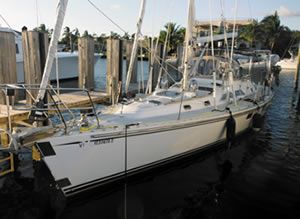
I am a part-time live-aboard and sail from Maine to Grenada. I have a mold problem on my two-year-old Shields VAC XHD series 148 waste hose. The sides of the hull are dry and clean, but the waste hose has a lot of mold. Is this due to the cooler seawater in the hose condensing moisture out of the warmer surrounding air? Could I insulate the hose to reduce this problem, and if so, what would you recommend as insulation?
Merrill Brown
Serenity, Shannon 43 ketch
Rodney Bay, St. Lucia
There are a few possible reasons for your sanitation hose growing mold. In colder climates/waters, condensation could be a factor, but its not likely to be the main cause-especially as youre currently in the Caribbean. In humid climates, the mold growth could be the result of poor ventilation around the hose. Or, it could be because the hose has begun permeating waste, which makes good mold food.
The XHD series 148 is not Shields premium hose, and there could be low levels of permeation after only two years-but that seems quite soon to us as none of our test hoses in service on the Chesapeake Bay have shown mold growth at the three-year mark.
Because it would be hard to pinpoint the cause definitively-and its likely a combination of factors-wed first try to simply clean the hose. Shields Product Manager Jim Lombardi recommends cleaning the outside of the hose with bleach or vinegar; do not use ammonia. You might try one of our top picks from the November 2013 review of mildew treatments and stain removers, or the homebrew cleaner we had success with. (See the Oct. 14, 2013 blog online for the recipe and links to more anti-mildew tips). Just be sure the cleaner you choose is safe to use on the hose material.
Shields also suggested trying to create better ventilation around the hose run and keeping the area cooler. Boosting ventilation isn’t always an option in bilges and head compartments where waste hoses live, so if cleaning doesn’t put an end to the mold growth, we would opt to replace the hose with a higher-quality product thats less likely to permeate. Insulating the hose by wrapping it in anything, even closed-cell foam, would be giving mold the perfect conditions to thrive in, dark and moist, between the hose and the insulating wrap, so skip insulating it-especially if youll be cruising humid areas.
Lombardi said that replacing the hose with Shields PolyX would provide better permeation protection and that the polyurethane hose has more insulation. We agree. Shields PolyX hose was the PS Best Choice pick in our most recent sanitation hose test (see PS April 2012 online). At nearly $20 per foot, the Poly Xs high quality comes at a high price. But it has shown no permeation in the ongoing long-term field test, and it has a smooth surface, making it very easy to clean. If thats too rich for your taste, consider replacing it with our Budget Buy pick, Trident 101/102, instead; the Trident runs about $8 per foot.
Youll find more information on sanitation hoses in the April 2012 test report and in our Marine Sanitation Systems ebook series. For more on mildew removers, check out our Essential Marine Cleaners ebook as well.





































